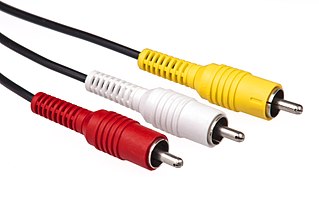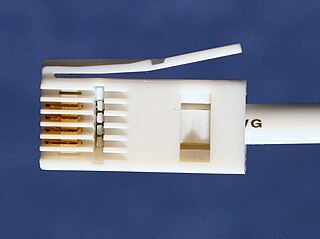
British Standards (BS) are the standards produced by the BSI Group which is incorporated under a royal charter and which is formally designated as the national standards body (NSB) for the UK. The BSI Group produces British Standards under the authority of the charter, which lays down as one of the BSI's objectives to:
Set up standards of quality for goods and services, and prepare and promote the general adoption of British Standards and schedules in connection therewith and from time to time to revise, alter and amend such standards and schedules as experience and circumstances require.

SCART is a French-originated standard and associated 21-pin connector for connecting audio-visual (AV) equipment. The name SCART comes from Syndicat des Constructeurs d'Appareils Radiorécepteurs et Téléviseurs, "Radio and Television Receiver Manufacturers' Association", the French organisation that created the connector in the mid-1970s. The related European standard EN 50049 has then been refined and published in 1978 by CENELEC, calling it péritelevision, but it is commonly called by the abbreviation péritel in French.
Big-5 or Big5 is a Chinese character encoding method used in Taiwan, Hong Kong, and Macau for traditional Chinese characters.

The RCA connector is a type of electrical connector commonly used to carry audio and video signals. The name RCA derives from the company Radio Corporation of America, which introduced the design in the 1930s. The connector’s male plug and female jack are called RCA plug and RCA jack.

"Schuko" refers to a plug/socket system used in much of Europe and in many countries east of there. It is a registered trademark referring to a system of AC power plugs and sockets that is defined as "CEE 7/3" (sockets) and "CEE 7/4" (plugs). A Schuko plug features two round pins of 4.8 mm diameter for the line and neutral contacts, plus two flat contact areas on the top and bottom side of the plug for protective earth (ground). The socket has a predominantly circular recess which is 17.5 mm deep with two symmetrical round apertures and two earthing clips on the sides of the socket positioned to ensure that the earth is always engaged before live pin contact is made. Schuko plugs and sockets are symmetric AC connectors. They can be mated in two ways, therefore line can be connected to either pin of the appliance plug. As with most types of European sockets, Schuko sockets can accept Europlugs. Schuko plugs are considered a very safe design when used with Schuko sockets, but they can also mate with other sockets to give an unsafe result.
The Hong Kong Supplementary Character Set is a set of Chinese characters – 4,702 in total in the initial release—used in Cantonese, as well as when writing the names of some places in Hong Kong.
AC power plugs and sockets connect electric equipment to the alternating current (AC) mains electricity power supply in buildings and at other sites. Electrical plugs and sockets differ from one another in voltage and current rating, shape, size, and connector type. Different standard systems of plugs and sockets are used around the world.

A telephone jack and a telephone plug are electrical connectors for connecting a telephone set or other telecommunications apparatus to the telephone wiring inside a building, establishing a connection to a telephone network. The plug is inserted into its counterpart, the jack, which is commonly affixed to a wall or baseboard. The standards for telephone jacks and plugs vary from country to country, though the 6P2C style modular plug has become by far the most common type.

Mains electricity by country includes a list of countries and territories, with the plugs, voltages and frequencies they commonly use for providing electrical power to low voltage appliances, equipment, and lighting typically found in homes and offices. Some countries have more than one voltage available. For example, in North America the supply to most premises is split-phase, with 240 volts between phases and 120 volts between either phase and neutral. Most sockets are connected to 120 V and neutral. By connecting across the phases, 240 V is available for large appliances. Often different sockets are mandated for different voltage or current levels.
In electricity supply design, a ring circuit is an electrical wiring technique in which sockets and the distribution point are connected in a ring. It is contrasted with the usual radial circuit, in which sockets and the distribution point are connected in a line with the distribution point at one end.

A standard Swedish telephone plug carries one telephone line and has four flat metal pins and one plastic pin. The design is only used in Sweden and older installations in Iceland. Neither plug nor socket is compatible with other plugs and sockets. It is defined in Swedish Standard SS 455 15 50.
Electrical wiring in the United Kingdom is commonly understood to be an electrical installation for operation by end users within domestic, commercial, industrial, and other buildings, and also in special installations and locations, such as marinas or caravan parks. It does not normally cover the transmission or distribution of electricity to them.

On commercial products, the presence of the logo means that the manufacturer or importer affirms the goods' conformity with European health, safety, and environmental protection standards. It is not a quality indicator or a certification mark. The CE marking is required for goods sold in the European Economic Area (EEA); goods sold elsewhere may also carry the mark.

The Europlug is a flat, two-pole, round-pin domestic AC power plug, rated for voltages up to 250 V and currents up to 2.5 A. It is a compromise design intended to connect low-power Class II appliances safely to the many different forms of round-pin domestic power socket used across Europe. However, it is not compatible with the rectangular-pin BS 1363 sockets found in Cyprus, Gibraltar, Singapore, Malaysia, United Arab Emirates, Hong Kong, Ireland, Malta and the United Kingdom. Europlugs are non-rewirable and must be supplied attached to a power cord.
This article exists to give readers an insight into electrical wiring in Hong Kong.

A modular connector is a type of electrical connector for cords and cables of electronic devices and appliances, such as in computer networking, telecommunication equipment, and audio headsets.

British telephone sockets were introduced in their current plug and socket form on 19 November 1981 by British Telecom to allow subscribers to connect their own telephones. The connectors are specified in British Standard BS 6312. Electrical characteristics of the telephone interface are specified by individual network operators, e.g. in British Telecom's SIN 351. Electrical characteristics required of British telephones used to be specified in BS 6305.

Plugs and sockets for electrical appliances not hardwired to mains electricity originated in the United Kingdom in the 1870s and were initially two-pin designs. These were usually sold as a mating pair, but gradually de facto and then official standards arose to enable the interchange of compatible devices. British standards have proliferated throughout large parts of the former British Empire.
Today there are approximately 20 types in common use around the world, and many obsolete socket types are still found in older buildings.












